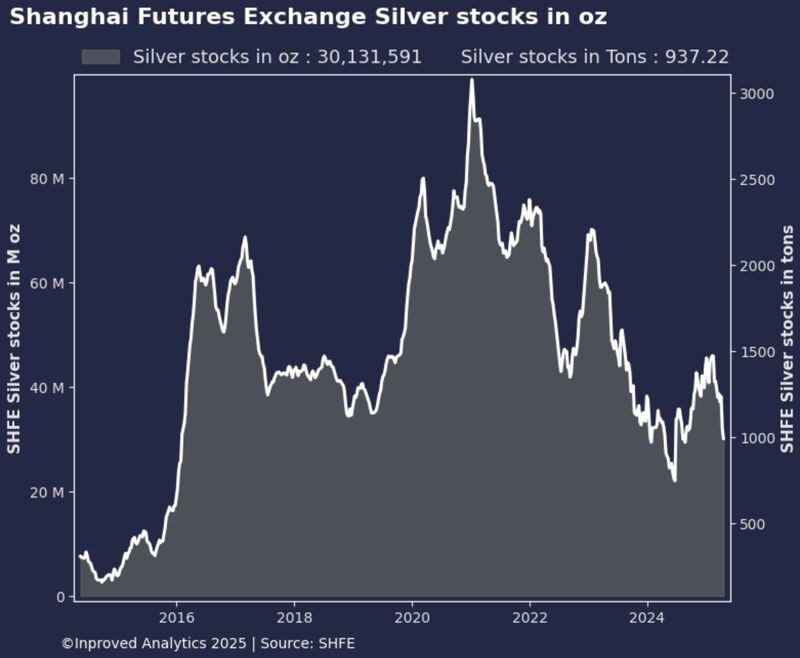| Procure investment-grade 1kg gold bars at spot +0.25%. Enquire within. |
| Procure investment-grade 1kg gold bars at spot +0.25%. Enquire within. |
As global attention pivots toward inflationary pressures, shifting trade dynamics, and the looming specter of renewed U.S.-China economic tension, the Chinese silver market is quietly undergoing one of its most significant supply contractions in nearly a year.
Data confirmed earlier this week shows that silver vaults in China have fallen to their lowest level in eight months, now sitting at just 937 metric tons — a new floor not seen since the summer of 2023. The pace of this drawdown has been nothing short of remarkable. Over the past two weeks alone, Shanghai has recorded 250 tons in outflows, with 55 tons leaving vaults this past week, following a 23-ton outflow the week before.

In total, year-to-date silver outflows now stand at 480 tons, according to data monitored by Hugo Pascal, Chief Investment Officer at InProved. “This is not just a supply trend,” Pascal explains. “This is an institutional shift in how physical silver is being treated inside China. We’re watching the vaults empty out at a rate that mirrors some of the most intense accumulation phases of the last five years.”
Pascal notes that the two consecutive weeks of outflows — totaling a quarter of a million kilograms — is a defining marker of a deeper structural behavior. Chinese market participants aren’t merely reallocating silver within domestic systems or preparing for refining cycles. They’re removing silver from visible, reportable vault infrastructure — likely into private holdings, long-term custodial accounts, or off-exchange warehousing.
This pattern has now repeated itself across three consecutive vault updates. Six days ago, the vaults stood at 969 tons, already dangerously close to critical levels. Today, that figure has fallen another 3.3%, breaking through the 950-ton psychological barrier, and pushing vaults into territory not seen since before Q3 2023.
What’s notable, Pascal points out, is the backdrop against which this is occurring. “We have rising premiums in the East, a weakening yuan, and continued concern about trade policy coming out of the U.S.,” he says. “All of this supports an environment where metals like silver — which carry both monetary and industrial value — are viewed as core to national resilience. This is a country acting to shield itself with physical assets.”
Indeed, while much of the Western silver narrative has focused on futures speculation, ETF positioning, and options volatility, the behavior in China has remained consistently physical. Vault withdrawals are often a better proxy for real demand than futures data. When silver leaves vaults, it’s being allocated with intent — and it’s rarely coming back anytime soon.
Moreover, this depletion is not occurring in a vacuum. China’s strategic push into solar manufacturing, EV components, and high-tech infrastructure — all sectors that are heavily silver-dependent — means that demand from industry is likely compounding the pressure from investors and state-aligned institutions seeking long-term hedges.
The divergence between East and West is becoming increasingly stark. While COMEX inventories have risen over the past month due to inflows ahead of delivery periods, Shanghai’s silver stockpiles have done the opposite. Pascal believes this divergence may become a key driver of price dislocation as we move into the next quarter. “If Chinese silver continues to drain at this pace, it will eventually begin to pull on global liquidity,” he notes. “Arbitrage traders, refiners, and even bullion banks will be forced to respond.”
And it’s not just the numbers — it’s the speed. “We’re looking at 250 tons gone in just 14 days,” Pascal emphasizes. “That’s not a minor adjustment. That’s urgency.”
For clients of InProved — particularly those active in silver supply chains or industrial planning — this data is vital. As inventories fall and premiums rise, the cost of sourcing physical metal may soon decouple further from benchmark pricing. Strategic hedging, long-term allocations, and delivery scheduling must now factor in what China is quietly telegraphing: silver is becoming scarcer, more valuable, and more closely tied to sovereign priorities.
As vault doors swing open in Shanghai and tonnage continues to disappear from sight, one thing is becoming undeniable — the East is not just buying silver; it’s taking it off the board.
About Us
Information
Individual Solutions
Commercial Solutions